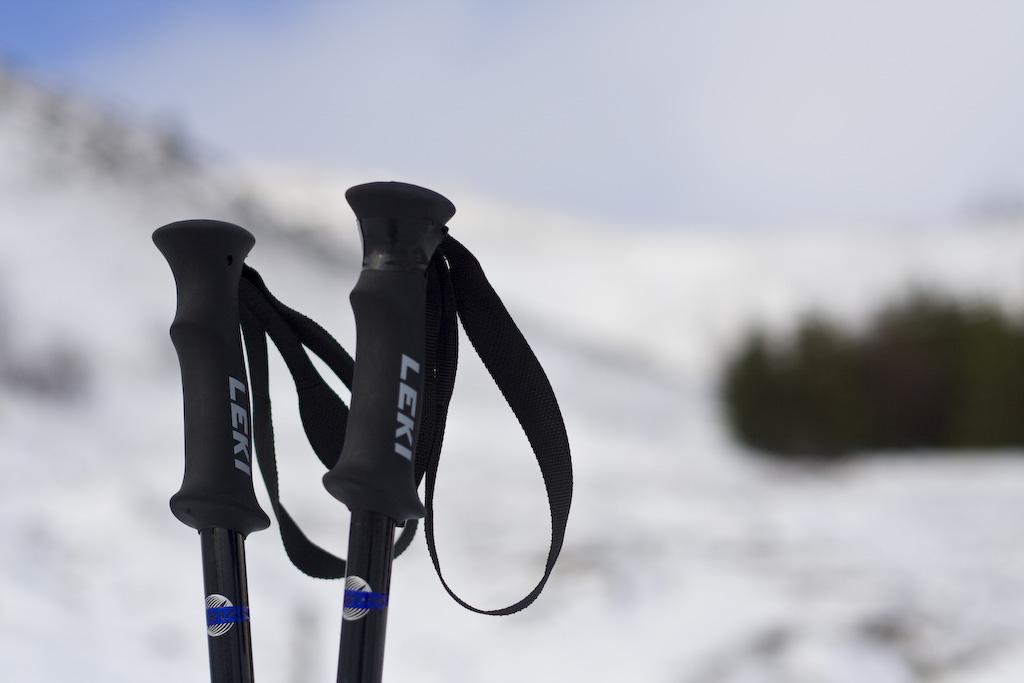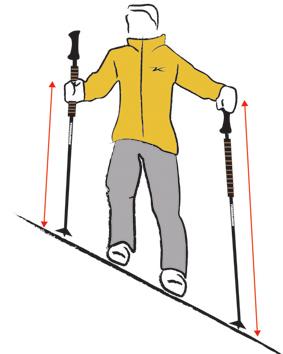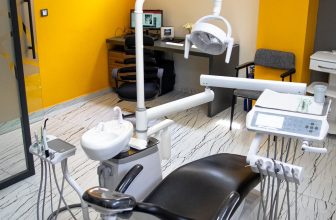
Trekking poles have become an invaluable tool for hikers and outdoor enthusiasts alike, providing stability and support on rugged terrains. Whether you are a seasoned adventurer or a novice hiker, knowing how to properly use trekking poles can greatly enhance your outdoor experience. In this article, we will delve into the ins and outs of trekking pole usage, offering guidance on how to choose the right poles, adjust them for optimal comfort, and master the correct technique for various terrains. So grab your poles and get ready to embark on a journey of knowledge, as we uncover the essential tips and tricks to make the most out of your trekking pole adventures.
Choosing the Right Trekking Poles for Your Adventure
Trekking poles are essential tools for outdoor enthusiasts who enjoy hiking, backpacking, or trekking adventures. Not only do they provide stability and support, but they also help alleviate strain on the knees, ankles, and feet. However, choosing the right trekking poles can be overwhelming with the variety of options available. Here are some key factors to consider when selecting the perfect trekking poles for your adventure.
Material: Trekking poles are commonly made from aluminum or carbon fiber. Aluminum poles are more durable and affordable, making them ideal for beginners or those on a budget. On the other hand, carbon fiber poles are lighter and absorb more shock, making them suitable for long-distance hikes or individuals looking to minimize weight.
Adjustability: Look for trekking poles that offer adjustable lengths. This feature allows you to adapt the poles to different terrains and your height preferences. Most adjustable poles have a mechanism that enables you to extend or retract them, ensuring a comfortable and secure grip as you traverse various landscapes.
Grip and Wrist Straps: The grip is an essential component of trekking poles as it affects your overall comfort and control. Opt for poles with ergonomic grips that provide a secure hold and minimize hand fatigue. Additionally, consider poles with adjustable wrist straps to further enhance stability and prevent dropping the poles accidentally.
Tip and Basket Design: The tip of your trekking poles should be durable and have excellent traction to provide stability on different surfaces. Some poles come with interchangeable tips, allowing you to switch between rubber, carbide, or metal depending on the terrain. Baskets are also essential in preventing the poles from sinking into soft ground or getting entangled in vegetation.
Extra Features: Some trekking poles offer additional features such as shock absorption systems, anti-shock mechanisms, or built-in cameras mounts. While these features may add weight to the poles, they can enhance your overall trekking experience. Consider your specific needs and preferences to determine if these extra features are worth the trade-off in weight.
Choosing the right trekking poles is crucial for a comfortable and safe adventure. Remember to test different models, gauge their weight and functionality, and get a feel for their grip and adjustability. By considering these factors and personalizing your selection, you’re sure to find the perfect trekking poles that suit your needs and accompany you on memorable outdoor excursions. So gear up, embrace the wilderness, and enjoy the wonders of nature with confidence, supported by your trusty trekking poles.

Proper Adjustments and Techniques for Efficient Use
When it comes to maximizing the benefits of using trekking poles, proper adjustments and techniques are key. Not only will this help you maintain balance and stability, but it will also increase your efficiency and reduce strain on your body. Here are some tips to ensure you make the most out of your trekking poles:
1. Adjusting the height
Maintaining the correct height for your trekking poles is crucial for efficient use. When holding the poles upright, your elbows should be at a 90-degree angle. If the poles are too short, it can cause you to lean forward and strain your back. On the other hand, if they’re too long, you may end up exerting unnecessary energy. Take the time to adjust the poles to a comfortable height before hitting the trail.
2. Using the straps
Don’t underestimate the importance of using the straps on your trekking poles. Securely sliding your hand through the strap and gripping the pole handles ensures a secure connection and prevents them from slipping away during vigorous movements. The straps should be snug but not too tight, allowing for proper circulation and movement of your hands.
3. Pole placement
Proper pole placement is vital for efficient use. When walking on flat terrain, plant your trekking poles slightly in front of you, parallel to each other. As you walk, try to keep your arm swings in sync with your opposite leg, mimicking a natural walking motion. When tackling uphill sections, shorten your poles and place them slightly ahead of you to push yourself upward. Conversely, for downhill sections, lengthen the poles and plant them slightly behind you to provide stability and support.
4. Using poles for balance
Trekking poles are not only helpful for navigating uneven terrains, but they also provide additional balance and support. When crossing streams, stepping on slippery rocks, or navigating steep slopes, use your poles to improve stability. By planting your poles firmly, you can distribute your weight evenly and reduce the risk of slips or falls, especially during tricky sections of your hike.
5. Maintaining a natural arm movement
Lastly, it’s crucial to maintain a natural arm movement while using trekking poles. Avoid tightly gripping the handles or using excessive force as it can lead to muscle fatigue and soreness. Instead, keep a relaxed grip and let the poles assist your movements without exerting unnecessary effort. This will help you conserve energy and enjoy your trekking experience to the fullest.

Enhancing Stability and Balance with Trekking Poles
Trekking poles are essential equipment for hikers and outdoor enthusiasts, offering numerous benefits in terms of stability, balance, and reducing stress on the body. Understanding how to properly use trekking poles can greatly enhance your hiking experience and make your journey safer and more enjoyable.
Setting the Correct Length
Before hitting the trails, it’s important to set the correct length for your trekking poles. Start by adjusting the pole to a length that allows your arm to be at a 90-degree angle when the pole’s tip touches the ground. Most trekking poles have adjustable sections that can be locked in place for a secure fit.
It is also worth considering shorter poles when hiking uphill and longer poles for downhill treks to maximize their benefits.
Proper Grip and Wrist Straps
Having a proper grip on your trekking poles is crucial for optimal performance. Hold the grip with a relaxed hand and make sure your wrist strap is properly adjusted to prevent strain. The wrist strap should comfortably loop around your wrist, allowing you to transfer weight to the poles without gripping them too tightly.
Remember, don’t grip the poles too tightly as it can cause unnecessary tension and fatigue in your hands and arms.
Walking Technique
When using trekking poles, it’s vital to maintain a synchronized walking technique to enhance stability. Start by planting the pole slightly ahead as your opposite leg moves forward. This technique helps to distribute your weight evenly and improves balance, especially on challenging terrains.
Ensure your poles retain constant contact with the ground, providing continuous support. With practice, you’ll develop a natural rhythm and gain confidence in your movements.
Trekking Pole Care
Proper maintenance of your trekking poles ensures their longevity and optimal performance. Regularly inspect the pole’s components for any signs of wear or damage, especially near the tips and locking mechanisms. Clean the poles after each hike to remove dirt or debris that may interfere with their functionality.
Lastly, when not in use, store your trekking poles in a cool, dry place to prevent corrosion and ensure they’re always ready for your next adventure.

Tips for Maintaining and Caring for Your Trekking Poles
Using trekking poles can greatly enhance your hiking experience by providing additional support, stability, and balance. However, it’s important to know how to properly use and care for your trekking poles to ensure their longevity and functionality. In this post, we will share some helpful .
1. Adjusting the Length:
- Before you start using your trekking poles, make sure they are adjusted to the correct length for your height.
- Stand upright with your arms relaxed at your sides, and adjust the poles so that your elbows are at a 90-degree angle when holding the grips.
- Most trekking poles come with adjustable sections, so you can easily lengthen or shorten them to find the perfect fit.
2. Regular Cleaning and Inspection:
- After each hike, take the time to clean your trekking poles to remove dirt, mud, and debris that may have accumulated.
- Inspect the poles for any signs of damage, such as cracks or bent sections, and ensure that the locking mechanisms are in good working order.
- If any damage is found, make necessary repairs or consider replacing the poles to avoid any accidents during your next trek.
3. Storing and Transporting:
- When not in use, store your trekking poles in a cool and dry place to prevent corrosion or damage.
- Avoid storing them in direct sunlight or extreme temperatures, as this can affect the materials and compromise their strength.
- If you’re traveling with your trekking poles, use protective sleeves or a carrying case to prevent scratches or other damage.
4. Changing Pole Tips:
- Over time, the tips of your trekking poles may wear down or become damaged, affecting their traction and grip.
- Most trekking poles come with replaceable tips that can easily be swapped out when needed.
- Regularly check the condition of your pole tips and replace them as necessary to ensure optimal performance on the trail.
5. Proper Usage Techniques:
- When using trekking poles, plant them firmly on the ground, slightly ahead of you, and apply pressure with each step.
- Use a light grip to prevent hand fatigue and allow for natural movement of the poles.
- Do not fully rely on your trekking poles to bear your entire weight; they should provide support and balance, but not carry the load.

Trekking Pole Accessories and Optional Attachments for Added Functionality
Trekking poles can significantly enhance your hiking experience by providing stability and support on rugged terrains. However, did you know that there are various accessories and optional attachments available that can add even more functionality to your trekking poles? In this section, we will explore some of these accessories and attachments that can enhance your trekking pole experience.
Trekking Pole Baskets: A trekking pole accessory that can be easily attached to the bottom of your poles is the trekking pole basket. These small disk-like attachments help prevent your poles from sinking into soft terrain, such as snow, sand, or loose soil. The baskets are especially useful during winter hikes or when traversing sandy or muddy trails.
Rubber Tips: If you plan on hiking on hard surfaces, such as pavement or rocky terrain, consider adding rubber tips to your trekking poles. These tips help provide traction on slippery surfaces and protect the hardened carbide tips of your poles from wearing down too quickly. They are also ideal for urban treks or when walking on sensitive surfaces where the metal tips may cause damage.
Camera Mounts: Capture stunning panoramic views or unique selfie shots without the need for an additional tripod by using trekking pole camera mounts. These attachments securely hold your camera or smartphone and can be adjusted to your desired angle, allowing you to take steady shots while on the move. Say goodbye to carrying bulky tripods and achieve the perfect shot effortlessly.
Compass and Thermometer: For those adventurers who like to explore off the beaten path, trekking poles with built-in compasses and thermometers can be incredibly handy. These attachments provide essential navigation tools and help you monitor the temperature to ensure you stay safe and prepared while out in the wild. Now, you won’t have to fumble around in your backpack to find your compass or thermometer when navigating unfamiliar territories.
Trekking Pole Storage Bag: Keep your trekking poles protected and organized with a dedicated storage bag. These bags are specifically designed to hold your poles and can conveniently fit into your backpack or attach to the outside using clips or straps. With a storage bag, you can easily transport your poles, prevent them from getting damaged, and keep all your hiking gear in one place.
As you can see, there are a plethora of accessories and optional attachments available to enhance the functionality of your trekking poles. Whether you’re looking for stability on various terrains, photographic opportunities, navigation aids, or better organization, there’s likely a trekking pole accessory out there to suit your needs. Explore the possibilities and take your hiking adventures to new heights with these valuable additions to your trekking gear arsenal.
Q&A
Q: What are trekking poles and how can they enhance my hiking experience?
A: Trekking poles, also known as hiking poles or walking sticks, are outdoor accessories that can greatly improve your hiking experience. They consist of two poles that are typically made from lightweight materials like aluminum or carbon fiber. The primary purpose of these poles is to provide stability and support while hiking, making it easier to navigate different types of terrain. They can also help reduce stress on your joints, increase your balance, and provide assistance during ascents and descents.
Q: How do I choose the right trekking poles for my needs?
A: The first step in choosing the right trekking poles is to consider the material they are made of. Aluminum poles are durable and affordable, making them a popular choice for beginners or those on a budget. Carbon fiber poles, on the other hand, are lighter and more expensive, making them suitable for more experienced hikers or those looking for minimal weight.
Additionally, you should consider the type of grip and handle that suits your preferences. Cork handles provide excellent grip and moisture-wicking properties, while rubber handles are more comfortable for longer hikes and offer better shock absorption. Finally, adjustable poles are recommended as they allow you to modify the length to accommodate different terrains and heights.
Q: How do I properly adjust and use trekking poles?
A: It’s important to adjust trekking poles to the correct length before using them. A simple guideline is to set the poles so that your elbow forms a 90-degree angle when holding onto the grip. For uphill sections, consider shortening the poles to provide better stability and enhance power during ascent. Conversely, when facing downhill sections, lengthen the poles to help absorb impact and protect your knees.
When using trekking poles, hold onto the grips firmly but without excessive tension. Start each step by planting the pole slightly ahead of you, then apply downward pressure as you step forward. This technique transfers weight off your knees and distributes it more evenly throughout your body, providing better stability on challenging terrain. Remember to always maintain a natural arm swing and adjust the rhythm of your pole usage according to your own comfort and hiking style.
Q: Are there any safety considerations when using trekking poles?
A: Absolutely. While trekking poles can enhance your hiking experience, it’s important to use them safely. Always inspect your trekking poles before each hike to ensure they are in good condition, paying attention to any signs of damage or loose parts. Additionally, practice using poles on flat terrain or easy trails before attempting more challenging hikes to become familiar with their handling and technique.
Keep in mind that trekking poles are not suitable for all hiking situations, such as extremely steep or technical climbs where the use of hands is required. Always be considerate of other hikers on crowded trails, especially when passing or hiking in groups. Lastly, make sure to adjust your pole length and grip during different terrains to ensure optimal stability and effectiveness.
Q: Can trekking poles also be used for other outdoor activities?
A: Certainly! While trekking poles are primarily associated with hiking and trekking, they can also be beneficial in various other outdoor activities. Nordic walking, for example, is a popular fitness activity that uses trekking poles to engage the upper body and provide an added workout during walks. They can also be useful for snowshoeing or cross-country skiing, where added stability and support are beneficial. Whether it’s a leisurely stroll or a more intense activity, trekking poles can enhance your experience and provide additional confidence in outdoor adventures.
Q: How do I care for and maintain my trekking poles?
A: Caring for your trekking poles is relatively simple. After each hike, wipe off any dirt or moisture and store them in a cool, dry place. This helps prevent corrosion and extends their lifespan. If your poles have adjustable mechanisms, periodically apply a small amount of lubricant or silicone spray to ensure smooth operation.
Regularly check the pole tips for signs of wear, as worn tips may affect stability and traction. Replace them if necessary, as many brands offer interchangeable tips or baskets that suit different terrains. Finally, if your poles have straps, adjust them properly to distribute weight efficiently and reduce strain on your wrists.
By following these simple maintenance practices, your trekking poles will remain in good condition, ready to accompany you on many more adventures. In conclusion, trekking poles are a valuable tool for anyone venturing into the great outdoors. By using these poles correctly, you can significantly enhance your hiking experience and improve your overall stability and balance. Remember to adjust your poles to the appropriate length, hold them properly with a relaxed grip, and utilize the correct technique when ascending, descending, or traversing uneven terrain.
Trekking poles offer numerous benefits, such as reducing strain on your knees and joints, improving your endurance, and providing additional support on challenging trails. Additionally, they can serve as handy tools for checking the depth of water or snow, warding off unwanted wildlife, or even doubling as tent poles in a pinch.
While there may be a slight learning curve when first using trekking poles, practice makes perfect. Take the time to familiarize yourself with your poles and experiment with different techniques to find what works best for you. Remember to consider the terrain, your personal strength and fitness, and any specific circumstances you may encounter on your trek.
Lastly, always prioritize safety and respect for the environment. Pack out any trash, follow designated trails, and be mindful of your impact on the wilderness. With the right mindset and knowledge on how to effectively use trekking poles, you’ll be well-equipped to enjoy your adventures into the great outdoors. So grab your poles, lace up your boots, and set off on your next thrilling trek – with confidence and stability by your side!






